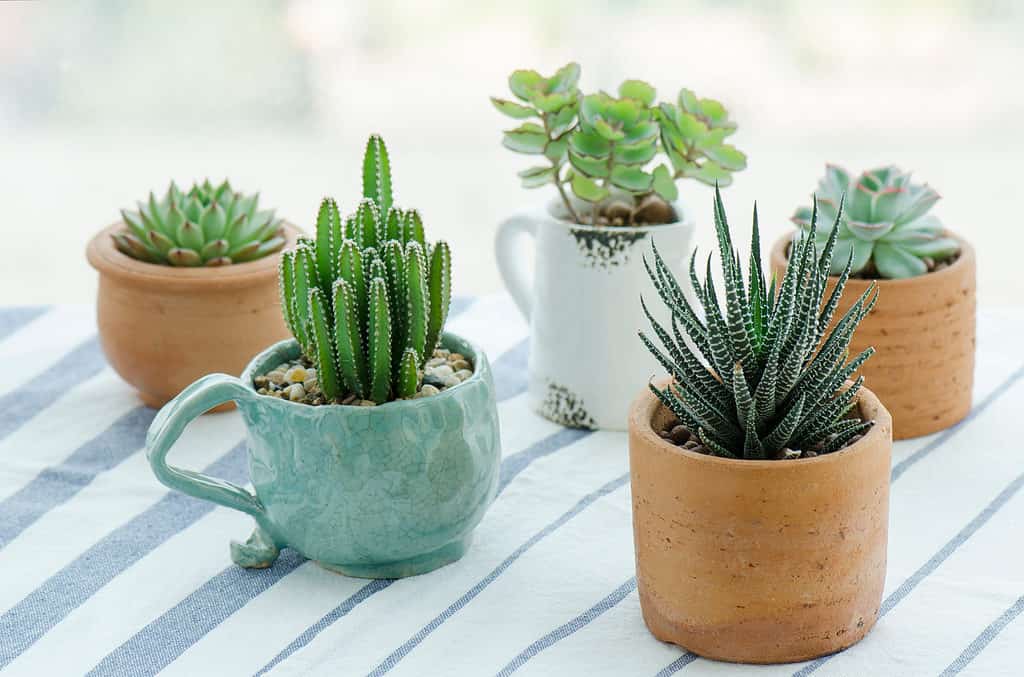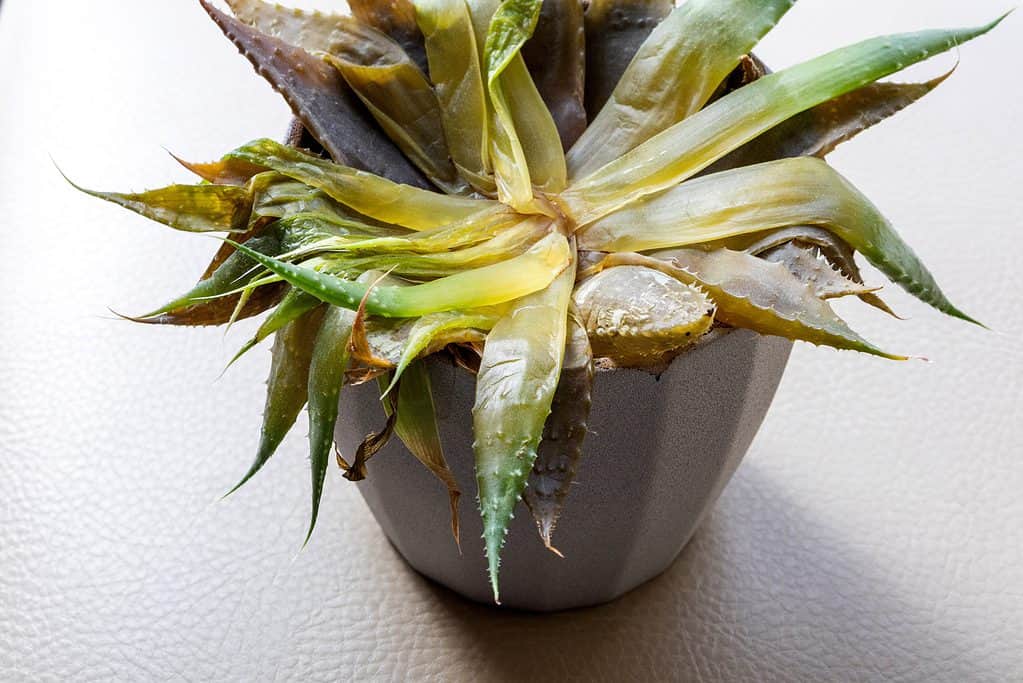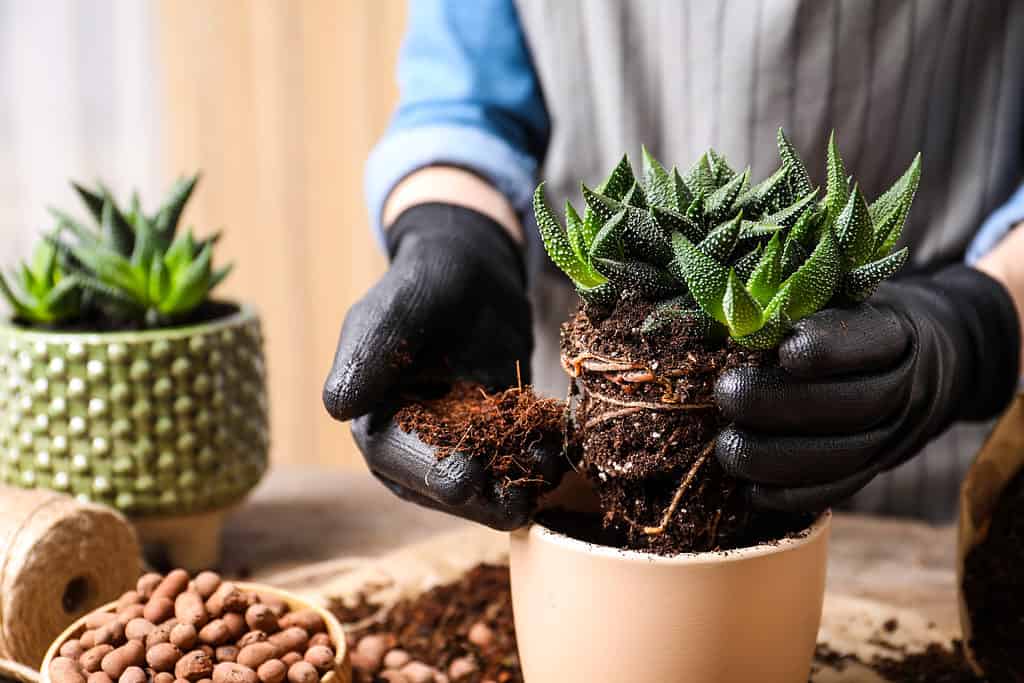Many people love succulents for their stunning variations and easy care requirements. While these plants are known to be drought-resistant, they do require regular watering for optimal health.
Unfortunately, many new succulent owners who recognize a problem with their plant think it must need more water. This tragic mistake can ultimately kill an otherwise healthy succulent.
This article will dive into how to tell the difference between an overwatered and underwatered succulent and how to save your plant from these situations.

Many people love succulents for their stunning variations and easy care requirements.
©panattar/Shutterstock.com
Signs of an Overwatered Succulent
Succulents are drought-resistant plants that store water in their leaves, stems, or roots, allowing them to survive in arid environments. When their water storage systems become full, they can no longer absorb the water surrounding their roots.
There’s a common misconception that giving your succulent too much water at one time will kill it. In reality, succulents love a good soak every few weeks. The problem with overwatering is continuous soil moisture that sits against the sensitive roots and causes root rot.
Here are the common signs of an overwatered succulent.
Soft or Mushy Leaves
Sure enough, soft, mushy, or yellowing leaves are the most obvious signs of overwatering. This can occur because the excess water in the soil causes the plant to rot from the inside out.
Yellow or Brown Leaves
The excess water in the succulent causes the cells in the leaves to break down and become discolored, leading to brown or yellow leaves.
Rotting or Black Roots
When a succulent is overwatered, the soil becomes waterlogged and doesn’t provide enough oxygen to the roots. This leads to the roots of the plant beginning to rot and eventually die. Root rot is one of the leading causes of succulent death.
Mold Growing on the Soil
Excess moisture often leads to mold growth in the soil. If you notice white fuzz growing on your soil, isolate the plant and repot it immediately. Mold growth doesn’t necessarily mean the roots are already damaged, so act quickly.
A Foul Smell
As your succulent begins to rot and break down, it will emit a foul odor. You may notice a musty smell before the rot sets in, indicating stagnant water in oversaturated soil.

One of the most obvious signs of overwatering your succulent is soft, mushy, or yellowing leaves.
©Adriana Marteva/Shutterstock.com
Problems Caused by Overwatering
Overwatering your succulent can cause several issues, ranging from moderate to severe. Here are some of the side effects of an overwatered succulent.
Root Rot
As mentioned, root rot is a serious issue that’s hard to correct. This is because the roots are unable to absorb the necessary oxygen and nutrients from the soil, eventually leading to the plant dying.
Fungal Growth
Overwatered soil is an ideal environment for fungal growth, which can further damage the roots of a succulent. Fungal diseases can also spread to other plants in the same container or nearby containers.
The most common include:
- Mold
- Mildew
- Blight
If you notice fungal growth on your succulent, isolate it away from other plants immediately.
Stunted Growth
Overwatering can cause a succulent to focus its energy on dealing with the excess water in the soil rather than growing and developing new leaves and stems. This can result in stunted growth and a weaker plant overall.
Leaf Drop
Some succulents are a bit dramatic and will convey their displeasure at being overwatered via leaf drop. This reaction is an indication that your succulent is stressed and needs immediate attention — not more water!
How to Save an Overwatered Succulent
If root rot hasn’t completely set in, you can save an overwatered succulent.
Take your succulent out of the pot and clear away the soil. Check the roots for signs of rot, trimming away affected areas. Let your succulent dry for a couple of days, keeping it away from direct sunlight to avoid burning the sensitive roots. Then, replant it in a new pot with fresh soil. Wait a week to water it.

You can often save an overwatered succulent by replanting it in a new pot with fresh soil.
©New Africa/Shutterstock.com
Signs of an Underwatered Succulent
Underwatering your succulent is preferable to overwatering it; succulents survive a lot longer in a dry environment compared to a humid one. However, they do require water for transferring energy and nutrients to promote growth.
Here are the common signs of an underwatered succulent.
Withered Leaves
As mentioned previously, succulents store water to survive in dry environments. When that water gets used up, it’ll appear similar to a deflated balloon. Shriveled, wrinkly leaves are a sign that your succulent needs a drink.
Discoloration
Without ample nutrients, your succulent may start to look faded or discolored. This is especially noticeable in succulents with bold color patterns, like the Echeveria agavoides ‘Lipstick.’
Soft Stems
Without ample hydration, your succulent stem may become soft and limp. This sign isn’t as noticeable on ground-level succulents but becomes apparent in stem succulents and cacti.
Soil Pulling
If the soil is dry and pulling away from the pot (i.e., it looks like a separate entity), your succulent needs a good soak.
Problems Caused by Underwatering
Underwatering can cause several long-term issues in your succulents. Some of the most common include:
Stunted Growth
As with overwatering, underwatering can lead to stunted growth. Without water, the succulent can’t transport energy and nutrients to promote growth.
Increased Vulnerability
If you notice a sudden influx of pests in your succulent, it could be a sign of underwatering. Pests and diseases often take hold of vulnerable plants that don’t have the energy to fight them off.
How to Save an Underwatered Succulent
Easy fix: give it some water.
However, it’s important to gradually water it to avoid shocking your plant. Gently pour water into the pot, allowing it to run through. Wait 5-10 minutes, then do another application. If the water runs through immediately, stop. Otherwise, wait another 5-10 minutes and give it a bit more.
If you regularly water your succulent but experience signs of underwatering, it could be a soil quality issue. If the water runs through right away, the roots likely don’t have enough time to absorb the moisture. Repot your succulent in well-draining soil with sand or perlite to improve the flow rate.

To avoid overwatering or underwatering your succulents check the soil weekly during the warm seasons and bi-weekly during the cold seasons.
©TSViPhoto/Shutterstock.com
Watering Your Succulents
The easiest way to avoid overwatering or underwatering your succulents is to set a reminder to check the soil weekly during the warm seasons and bi-weekly during the cold seasons.
Stick your finger into the soil and determine whether it’s dry or damp. If it’s dry, it’s time for watering. If it’s damp, wait a couple more days.
The photo featured at the top of this post is © Ilina Yuliia/Shutterstock.com
Thank you for reading! Have some feedback for us? Contact the AZ Animals editorial team.






